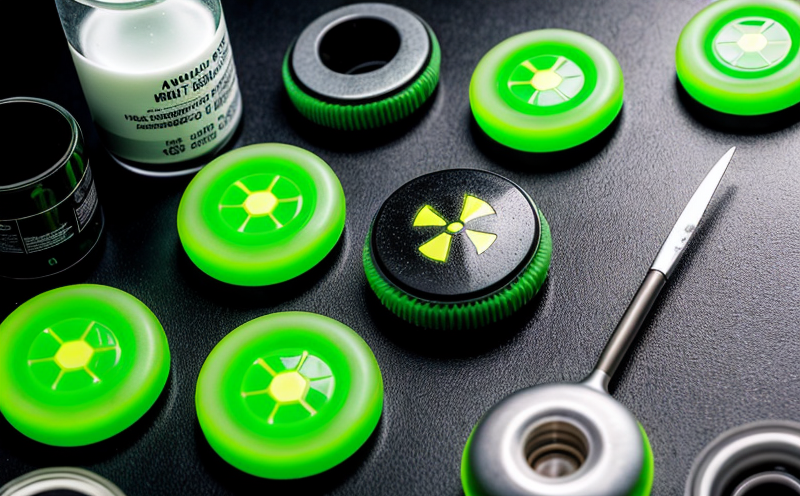ISO 16966 Radon Emanation Testing in Packaged Foods
The ISO 16966 standard provides a method for measuring radon emanation from packaged foods. This test is crucial for ensuring the safety and quality of food products, especially those intended for long-term storage or distribution. Radon, a radioactive gas derived from the decay of uranium in soil, rock, and water, can accumulate within packaging materials used for food. Elevated levels of radon can lead to increased exposure risks, particularly during transportation and consumption.
The testing procedure outlined in ISO 16966 involves placing samples of packaged foods into airtight containers under controlled conditions. The container is then sealed for a specified period to allow any radon that may have been present in the packaging materials or the food itself to emanate out. After this incubation period, the sample is removed and analyzed using an alpha spectrometer to measure the concentration of radon released.
The primary goal of ISO 16966 testing is to ensure compliance with relevant regulatory standards such as the European Union’s regulation on limits for radioactive substances in foodstuffs. By adhering to this standard, manufacturers can demonstrate that their products meet stringent safety requirements and provide consumers with peace of mind regarding potential health risks.
Another critical aspect of ISO 16966 testing is its role in quality control processes within the food industry. It allows for early detection of any issues related to packaging materials or production practices that could contribute to radon contamination. This proactive approach helps companies maintain their reputation and comply with international standards.
Additionally, ISO 16966 testing plays a vital part in safeguarding public health by reducing the likelihood of consumer exposure to harmful levels of radon. By implementing this test as part of routine quality assurance measures, food producers can contribute significantly to maintaining high standards of safety and integrity across their supply chain.
In summary, ISO 16966 testing serves multiple purposes in ensuring the safety and quality of packaged foods. It helps identify potential risks early on, supports regulatory compliance, enhances product reputation, and contributes to public health protection.
Benefits
- Enhanced Product Safety: Ensures that food products do not contain harmful levels of radon, thus protecting consumers from potential health risks.
- Regulatory Compliance: Helps manufacturers adhere to international standards and local regulations related to radioactive substances in foodstuffs.
- Improved Reputation: Demonstrates a commitment to quality and safety, which can enhance brand reputation and customer trust.
- Early Detection: Allows for timely identification of any issues with packaging materials or production processes.
The benefits extend beyond mere compliance; they represent a proactive stance towards ensuring the highest standards of food safety. This not only protects consumers but also strengthens brand loyalty and market position.
Why Choose This Test
Selecting ISO 16966 radon emanation testing for packaged foods is essential given today’s heightened awareness about product safety and quality assurance. Here are several compelling reasons why this test should be a priority:
Comprehensive Coverage: The test covers the entire supply chain, from raw materials to final packaging. This comprehensive approach ensures that all potential sources of radon are identified.
Scientific Validation: ISO 16966 is based on rigorous scientific research and has been validated by leading experts in the field of food safety. Its accuracy and reliability make it a trusted choice for quality assurance.
Industry Trust: Numerous top-tier companies already rely on this testing method to maintain their product standards. By adopting ISO 16966, you can align your practices with industry best practices and gain recognition as a leader in food safety.
Economic Advantages: Early detection of issues through this test can prevent costly recalls and damage to brand reputation. It also allows for corrective measures to be implemented before they become major problems.
In conclusion, choosing ISO 16966 radon emanation testing is not just a regulatory requirement but an investment in your business’s future success. It ensures that your products meet the highest safety standards and can be trusted by consumers worldwide.
Environmental and Sustainability Contributions
The practice of ISO 16966 radon emanation testing contributes significantly to environmental sustainability by promoting safer food production practices and reducing waste. By ensuring that products are free from harmful levels of radon, this testing helps protect the environment from unnecessary contamination.
- Reduction in Contamination: Eliminating radon contamination minimizes the risk of it entering ecosystems and affecting wildlife.
- Enhanced Resource Efficiency: By identifying and addressing potential issues early on, ISO 16966 helps prevent resource wastage associated with product recalls or reprocessing.
- Sustainable Brand Image: Adhering to this standard enhances your brand’s reputation as a responsible corporate citizen, which is increasingly important for consumer trust in the global market.
Through these contributions, ISO 16966 plays an integral role in fostering sustainable development practices within the food industry. It supports not only immediate safety but also long-term environmental health and resource conservation efforts.





